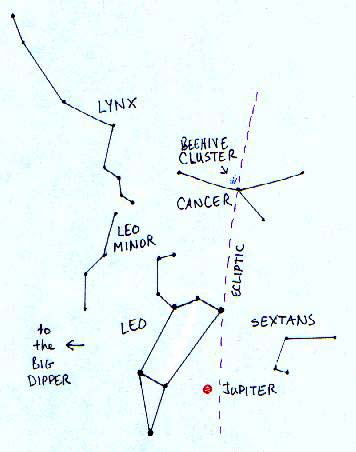In early March, the dominant constellation of spring, Leo the Lion, rears
up from the eastern horizon at dusk and is visible throughout the night.
It is particularly easy to find this year because Jupiter is nearby.
Another returning favorite is the Big Dipper in Ursa Major. The Dipper hasn't
exactly been gone for those of us in the mid-northern latitudes, but it spends
winter evenings sitting close to the horizon. By March, it is rising in the
northeast at sunset, and circles over the North Pole during the night.
But Leo, almost half a sky away from the winter Milky Way, is surrounded
on all sides by faint constellations. They are challenging to see under good
viewing conditions, and may prove to be impossible from the city, particularly
this week with a waxing gibbous moon. Still, we like to be thorough here
at Backyard Astronomy, so let's take a quick tour.

Midway between Leo and the Big Dipper is another lion, Leo Minor. Leo Minor
resembles a bent stick. (Note that, unlike Ursa Major, the big Leo is not
referred to as "Leo Major." It is just Leo.) Another cat, Lynx, is between
Ursa Major and Gemini. It resembles a longer bent stick. There are no ancient
stories attached to either of these constellations. In fact, they weren't
identified as constellations until the seventeenth century, when German astronomer
Johannes Hevelius decided to fill in some of the less-exciting areas of the
sky. Supposedly, he selected the name Lynx because one would need "the eyes
of a lynx" to be able to see it.
Continuing around, a better known constellation, Cancer the Crab, is between
Leo and Gemini. It is as faint as Lynx, and derives most of its attention
from its position in the zodiac. Its central star is right on the ecliptic.
Right now, that star is about halfway between Regulus (the front foot of
Leo) and Saturn (in the foot of Gemini.) Very near the central star is M44,
the Beehive Cluster, which is easily seen from the city with binoculars.
At the foot of Leo is another Hevelius constellation, Sextans the Sextant.
It should come as no surprise by now that Sextans resembles a bent stick.
The surprise is that it is not another feline. Hevelius created his own instruments
for taking astronomical measurements. This constellation commemorates his
favorite sextant which was destroyed by a fire at his home.
But so what if the constellations are not spectacular? The planets are putting
on an outstanding show, with the four brightest all visible in the early
evening. Venus is unmistakably bright in the west. Mars is higher, far less
bright than it was in summer, but clearly reddish, and located near the Pleiades.
The gibbous moon will be near Saturn in Gemini on the night of February 29/March
1. A few days later, the moon will pass near Leo. On March 6, Jupiter will
be about 3 degrees above the full moon.
0 Reader Comments

The Piker Press moderates all comments.
Click here for the commenting policy.